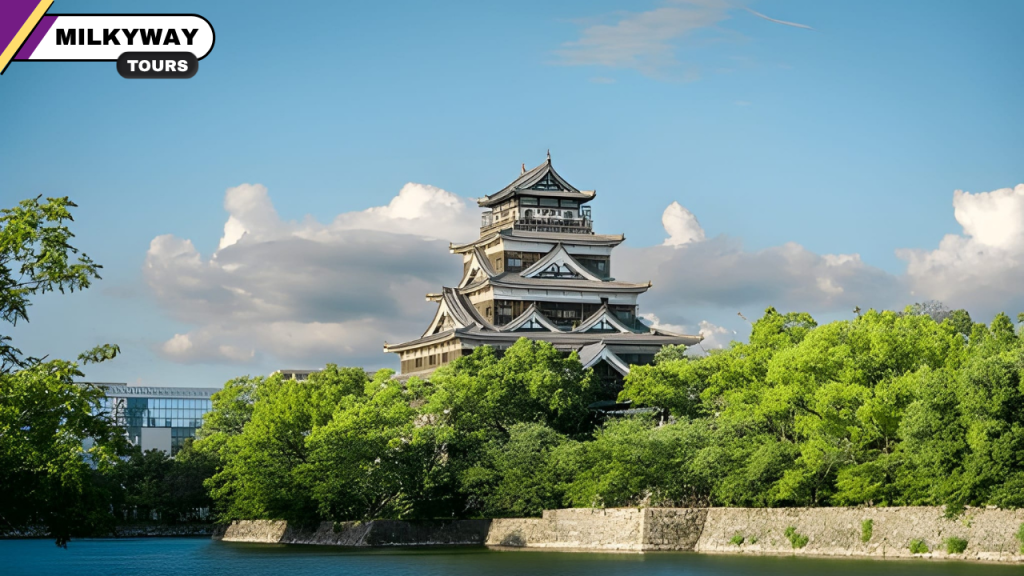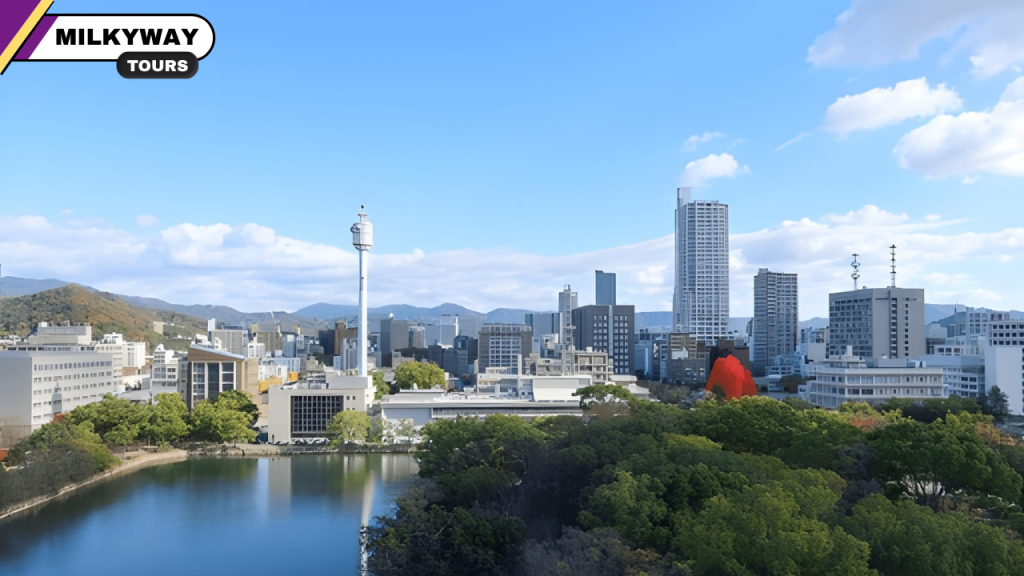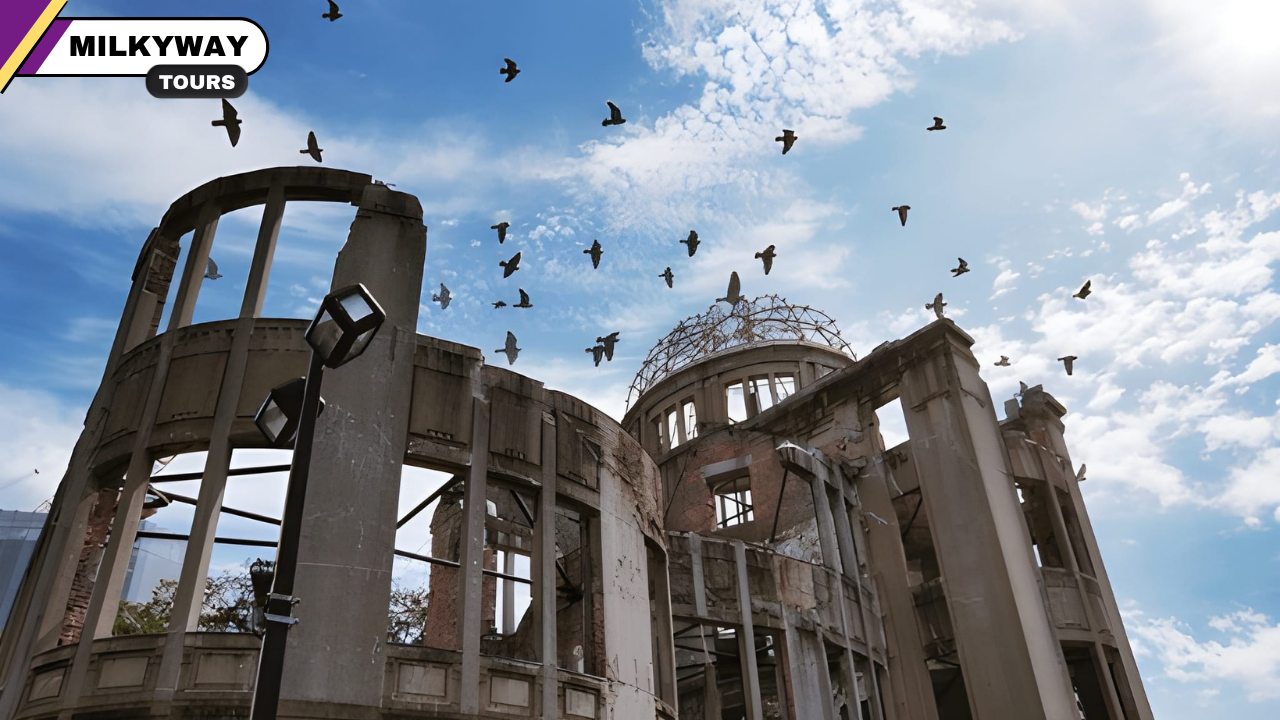Hiroshima, a city that embodies resilience, remembrance, and renewal, stands as a poignant testament to peace in 2025. Rising from the ashes of August 6, 1945, it has transformed into a vibrant hub of culture, history, and natural beauty, drawing millions to reflect on humanity’s past while celebrating its future.
This comprehensive guide invites you to explore Hiroshima through its memorials, museums, culinary delights, and serene landscapes, ensuring a meaningful journey that honors its legacy.
From the haunting Peace Memorial Park to the lush Miyajima Island, discover how Hiroshima captivates hearts and inspires hope.
Hiroshima’s Story of Resilience
Hiroshima’s narrative is one of profound tragedy and extraordinary rebirth. The world’s first atomic bombing claimed over 140,000 lives, yet the city rebuilt with a commitment to peace, becoming a global symbol against nuclear weapons. In 2025, Hiroshima continues to evolve, with new interactive exhibits at the Peace Memorial Museum and eco-initiatives in Shukkeien Garden, blending reflection with forward-looking optimism. Visiting Hiroshima isn’t just sightseeing—it’s a journey of empathy and inspiration, perfect for those seeking depth beyond typical travel.
Iconic Memorials and Museums
Peace Memorial Park and Atomic Bomb Dome
The heart of Hiroshima, Peace Memorial Park, spans 120,000 square meters and honors victims with poignant monuments. The Atomic Bomb Dome (Genbaku Dome), a preserved ruin of the Prefectural Industrial Promotion Hall, stands as a stark reminder of the blast’s devastation—just 160 meters from ground zero.
- What to See: The Children’s Peace Monument, adorned with colorful origami cranes symbolizing hope, and the Flame of Peace, which burns until all nuclear weapons are abolished.
- 2025 Highlight: Augmented reality (AR) apps at the park overlay historical images, bringing 1945 to life via your smartphone.
- Pro Tip: Visit at dawn for solitude; entry is free, but guided tours (~$10) provide deeper context.
Hiroshima Peace Memorial Museum
This museum, a short walk from the park, chronicles the bombing’s impact through artifacts, survivor testimonies, and reconstructed city models. Exhibits evoke the human cost, from melted artifacts to personal stories of survival.
- Duration: 1–2 hours; ~$2 entry.
- Pro Tip: Audio guides (~$3) in multiple languages; prepare emotionally—many visitors leave moved to tears.
| Site | Location | Cost | Duration | Best Time |
|---|---|---|---|---|
| Peace Memorial Park | Central Hiroshima | Free | 1–2 hours | Early morning |
| Atomic Bomb Dome | Park edge | Free | 30 minutes | Sunset |
| Peace Memorial Museum | Park interior | $2 | 1–2 hours | Midday |
Cultural and Historical Immersion
Hiroshima Castle (Gokamura Castle)
Rebuilt in the 1950s, this striking black-and-white fortress overlooks the city, housing exhibits on samurai history and feudal artifacts. Climb to the top for panoramic views.
- Highlight: The Treasure Hall displays armor and swords (~$5 extra).
- Pro Tip: Visit in spring for cherry blossoms framing the castle; ~$6 entry.
Shukkeien Garden
A 17th-century landscape garden with ponds, tea houses, and seasonal flowers, Shukkeien provides a serene escape. Stroll koi-filled paths or sip tea in a traditional pavilion (~$3).
- 2025 Update: New eco-workshops teach bonsai pruning.
- Pro Tip: Pair with a visit to the adjacent Hiroshima Gokamura Castle for a full day.
Okunoshima Island: The Rabbit Island
A 30-minute ferry from Tadanoumi Port (~$20 round-trip), this former chemical weapons site is now a rabbit sanctuary with over 1,000 friendly bunnies. Hike trails or picnic on the beach.
- Why Go: A whimsical contrast to Hiroshima’s heavier themes.
- Pro Tip: Bring rabbit food (~$1); visit mid-week to avoid ferry crowds.

Culinary Delights in Hiroshima
Okonomiyaki: Hiroshima-Style
Hiroshima’s layered okonomiyaki (~$8–$12) differs from Osaka’s—cabbage, noodles, egg, and toppings grilled at your table. Try it at Okonomimura Village, a multi-floor food hall with 25 stalls.
- Pro Tip: Add oysters or squid for a local twist; book tables during peak hours.
Oysters and Seafood
Hiroshima produces 70% of Japan’s oysters. Freshly grilled or raw at Miyajima’s floating stalls (~$5–$10), they’re a must-try.
- 2025 Trend: Sustainable oyster farms with farm-to-table tours (~$20).
- Pro Tip: Visit during Setouchi Oyster Festival (January–March).
| Dish | Spot | Cost | Must-Try | Why Hiroshima? |
|---|---|---|---|---|
| Okonomiyaki | Okonomimura | $8–$12 | Layered style | City specialty |
| Grilled Oysters | Miyajima stalls | $5–$10 | Fresh from bay | 70% of Japan’s supply |
| Momiji Manju | Souvenir shops | $2–$5 | Maple leaf sweets | Local confection |
Outdoor Adventures and Nature
Miyajima Island (Itsukushima Shrine)
A 10-minute ferry from Miyajimaguchi ($4 round-trip), Miyajima is home to the floating torii gate of Itsukushima Shrine (UNESCO site, ~$3 entry). Hike Mount Misen (2 hours, moderate) for panoramic views.
- Highlight: Deer roam freely—feed them rice crackers (~$1).
- Pro Tip: Visit at high tide (check schedules) for the torii’s full effect.
Sandankyo Gorge
A 1-hour drive from Hiroshima ($50 taxi), this gorge features waterfalls and basalt columns. Hike the 4-km trail (2 hours, easy) for misty cascades.
- 2025 Update: New eco-bridges improve accessibility.
- Pro Tip: Spring for cherry blossoms; bring waterproof shoes.
Setoda Island: Citrus Orchards
A 1.5-hour ferry from Hiroshima ($20), Setoda’s terraced mikan (mandarin) orchards offer picking ($10/basket). Cycle through the fields (~$5 rental) for rural charm.
- Pro Tip: Taste mikan soft serve (~$3) at local shops.
Nightlife and Shopping
Hiroshima Nightlife: Peace Bell and Bars
Ring the Peace Bell in the park (free, evenings) for a reflective moment, then head to Ekimae’s craft beer bars (~$5–$10/pint). Try local brews like Hiroshima Premium Lager.
- Pro Tip: Join a bar crawl (~$20) for guided tastings.
Shopping: Hondori Arcade
Hiroshima’s covered arcade offers souvenirs like origami cranes ($5) and A-bomb survivor art ($20–$50). 2025 features pop-up eco-shops.
- Pro Tip: Buy tax-free (10% off over ~$50); visit evening for street performers.

Practical Tips for Your Hiroshima Trip
Best Time to Visit
Spring (March–May) for cherry blossoms; autumn (October–November) for foliage. Summer festivals (August) are lively; winter (December–February) is quiet.
- Pro Tip: Check Fuji visibility apps for clear days.
Getting Around Hiroshima
Use the Hiroshima Sightseeing Loop Bus ($7/day pass) for 8 key sites. Streetcars ($1.50/ride) cover downtown; taxis start at ~$5.
- Hack: Rent a bike (~$10/day) for Miyajima Island.
Where to Stay
Central hotels like Rihga Royal ($100–$200/night) near the park; budget options like APA Hotel ($50–$80). Miyajima ryokan (~$150/night) for island stays.
- Pro Tip: Book near Peace Park for easy access.
Safety and Etiquette
Hiroshima is safe, but respect memorials—quiet reflection, no photos of exhibits without permission. Follow COVID-era mask etiquette in crowds.
- Pro Tip: Carry yen; some shops are cash-only.
| Transport | Cost | Coverage | Pro Tip |
|---|---|---|---|
| Sightseeing Bus | $7/day | 8 sites | Hop-on/hop-off |
| Streetcar | $1.50/ride | Downtown | ICOCA card compatible |
| Bike Rental | $10/day | Miyajima | Helmets included |
Conclusion
Hiroshima in 2025 is a city of profound peace and vibrant history, inviting reflection and renewal. From the poignant Peace Memorial to Miyajima’s floating torii, it weaves tragedy with triumph. Explore with respect, savor its oysters and okonomiyaki, and leave inspired by its message of hope. Hiroshima isn’t just a destination—it’s a reminder of humanity’s strength.
FAQs
What is the Peace Memorial Park?
A 120,000 sqm park honoring 1945 bombing victims, featuring monuments like the Atomic Bomb Dome and Children’s Peace Statue.
How do I get to Miyajima from Hiroshima?
Take a 45-minute train to Miyajimaguchi ($3), then a 10-minute ferry ($4 round-trip).
Is Hiroshima safe for tourists?
Yes, with low crime and efficient public transport; crowds are managed at memorials.
What’s the best food in Hiroshima?
Hiroshima-style okonomiyaki ($8–$12) and fresh oysters ($5–$10) from Miyajima.
When’s the best time to visit Hiroshima?
Spring for cherry blossoms or autumn for foliage; summer for festivals.


